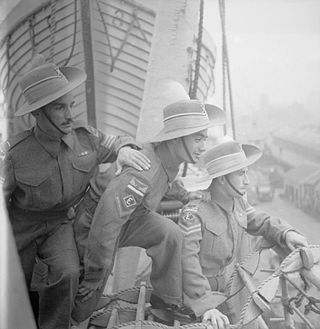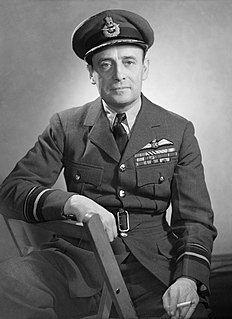The No.1 Armoured Car Company RAF was a military unit of Britain's Royal Air Force (RAF) based in Iraq and which played a role in the defence of RAF Habbaniya during World War II.
On 19 December 1921, "No. 1 Armoured Car Company RAF" was formed at Heliopolis in the Kingdom of Egypt and then moved to Palestine, being disbanded there on 1 December 1923 with elements being absorbed into No. 2 Armoured Car Company RAF. [1] During the 1920s further RAF Armoured Car Companies (Nos 3, 4, 5 & 6) were formed in Iraq but by 1930 they were consolidated into No. 1 Company with its base at RAF Hinaidi and sections at Mosul and RAF Shaibah. [2]
During the Anglo-Iraqi War, the No. 1 Armoured Car Company RAF was composed of eighteen Rolls-Royce armoured cars [3] and several Morris tenders. These vehicles were among the last of a consignment of ex-Royal Naval Armoured Car Division armoured cars that had been serving in the Middle East since 1915. [4] In addition to the Rolls-Royce armoured cars, the company had two ancient tanks, named "Walrus" and "Seal." [5]
The company was organised into a headquarters and three sections. Each section had six armoured cars and two wireless tenders. The make-up of the company did however vary from time to time. Various sections would be detached to other RAF bases in Iraq and on various duties throughout Iraq (and even beyond).
The company was based at RAF Hinaidi Cantonment until it moved to RAF Habbaniya in 1936 (and Hinaidi became the Iraqi Rashid Airbase). RAF Habbaniya had purpose built, modern facilities for both men and machines in the Armoured Car Lines.
On 3 October 1946 the company was incorporated into the RAF Regiment and named No. 2701 Armoured Squadron. [6] On 25 February 1947, this unit was renamed No. 1 Squadron RAF Regiment. [7]

A military armoredcar is a lightweight wheeled armored fighting vehicle, historically employed for reconnaissance, internal security, armed escort, and other subordinate battlefield tasks. With the gradual decline of mounted cavalry, armored cars were developed for carrying out duties used to be assigned to light cavalry. Following the invention of the tank, the armored car remained popular due to its faster speed, comparatively simplified maintenance and low production cost. It also found favor with several colonial armies as a cheaper weapon for use in underdeveloped regions. During World War II, most armored cars were engineered for reconnaissance and passive observation, while others were devoted to communications tasks. Some equipped with heavier armament could even substitute for tracked combat vehicles in favorable conditions—such as pursuit or flanking maneuvers during the North African Campaign.

The Royal Naval Air Service (RNAS) was the air arm of the Royal Navy, under the direction of the Admiralty's Air Department, and existed formally from 1 July 1914 to 1 April 1918, when it was merged with the British Army's Royal Flying Corps to form the Royal Air Force (RAF), the world's first independent air force.

The Royal Air Force Regiment is part of the Royal Air Force and functions as a specialist corps. Founded by royal warrant in 1942, the Corps carries out soldiering tasks relating to the delivery of air power. Examples of such tasks are non-combatant evacuation operation (NEO), recovery of downed aircrew, and in-depth defence of airfields by way of aggressively patrolling and actively seeking out infiltrators in a large area surrounding airfields. In addition the RAF Regiment provides Joint Terminal Attack Controllers (JTACs) to the British Army and Royal Marines, and provides flight size commitment to the Special Forces Support Group.

The Rolls-Royce Armoured Car was a British armoured car developed in 1914 and used during the First World War, Irish Civil War, the inter-war period in Imperial Air Control in Transjordan, Palestine and Mesopotamia, and in the early stages of the Second World War in the Middle East and North Africa.

The Anglo-Iraqi War was a British-led Allied military campaign during the Second World War against the Kingdom of Iraq under Rashid Gaylani, who had seized power in the 1941 Iraqi coup d'état, with assistance from Germany and Italy. The campaign resulted in the downfall of Gaylani's government, the re-occupation of Iraq by the British, and the return to power of the Regent of Iraq, Prince 'Abd al-Ilah, a British ally.
Iraq Command was the Royal Air Force (RAF) commanded inter-service command in charge of British forces in Iraq in the 1920s and early 1930s, during the period of the British Mandate of Mesopotamia. It continued as British Forces in Iraq until 1941 when it was replaced by AHQ Iraq. It consisted of Royal Air Force, Royal Navy, British Army, Commonwealth and locally raised units, commanded by an RAF officer normally of Air Vice-Marshal rank.

Royal Air Force Habbaniya, more commonly known as RAF Habbaniya, , was a Royal Air Force station at Habbaniyah, about 55 miles (89 km) west of Baghdad in modern-day Iraq, on the banks of the Euphrates near Lake Habbaniyah. It was developed from 1934, and was operational from October 1936 until 31 May 1959 when the RAF finally withdrew after the July 1958 Revolution made the British military presence no longer welcome. It was the scene of fierce fighting in May 1941 when it was besieged by the Iraqi Military following the 1941 Iraqi coup d'état.

The II Squadron RAF Regiment is a parachute-trained Field Squadron of RAF Regiment based at RAF Brize Norton.

The Assyrian Levies were the first Iraqi military force established by the British in British controlled Iraq. The Iraq Levies originated in a local Arab armed scout force raised during the First World War. After Iraq became a British Mandate, the force became composed mostly of Assyrians, Kurds and Iraqi Turkmen who lived in the north of the country, while the nascent Iraqi Army was recruited first from the Arabs who had joined the Iraqi Levies and later from the general Arab population (Beth-Kamala). Eventually the Levies enlisted mainly Assyrian soldiers with British officers. The unit initially defended the northern frontiers of the Province of Mosul when Turkey claimed the province and massed its army across the frontiers. After 1928 the prime role of the Levies was to guard the Royal Air Force bases located in Iraq.
Iraqforce was a British and Commonwealth formation that came together in the Kingdom of Iraq. The formation fought in the Middle East during World War II.

General Sir Ouvry Lindfield Roberts, was a senior officer of the British Army and the British Indian Army during the First and Second World Wars.
Michael Peter Casano, MC, was a Squadron Leader in the Royal Air Force during the Second World War.
The Number 2 Armoured Car Company RAF was a military unit of the British Royal Air Force (RAF) which was based at Amman in what was then called the Transjordan. It was the counterpart of No.1 Armoured Car Company RAF, which performed a similar role in Iraq.

Harry George Smart, is best known for having been the commander of RAF Habbaniya during the first part of the Anglo-Iraqi War. Smart was an officer in the British Army, the Royal Flying Corps and the Royal Air Force. He served during the First World War, during the interwar period, and during the Second World War.

Royal Air Force Hinaidi or more commonly known as RAF Hinaidi, is a former Royal Air Force station near Baghdad in the Kingdom of Iraq. It was operational from 1922 until 1937, when operations were transferred to RAF Habbaniya.
Gocol was a flying column created by the British Army shortly after the Anglo–Iraqi War had ended.
Kingcol was a British Army flying column created during the Anglo-Iraqi War.
Habforce was a British Army military unit created in 1941 during the Anglo-Iraqi War and still active during the Syria-Lebanon campaign during the fighting in the Middle East in the Second World War.
Mercol was a flying column created by the British Army shortly after the Anglo-Iraqi War had ended.

The RAF Armoured Car Companies were part of Britain's Royal Air Force (RAF) based in Iraq, Palestine and Transjordan. They were formed to operate with aircraft squadrons to suppress insurrection and maintain peace in the area in the aftermath of World War I.